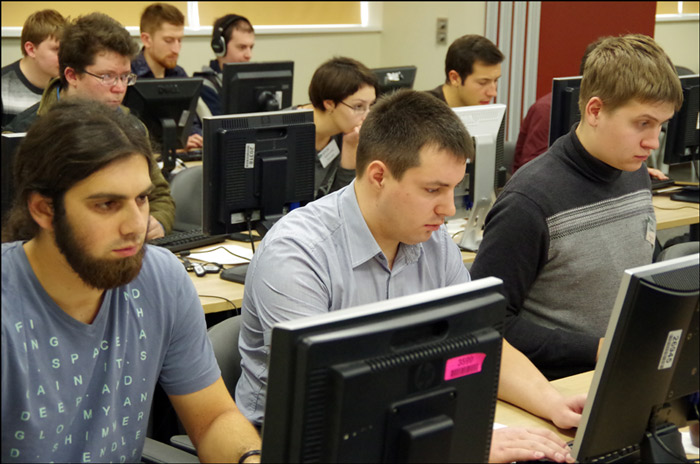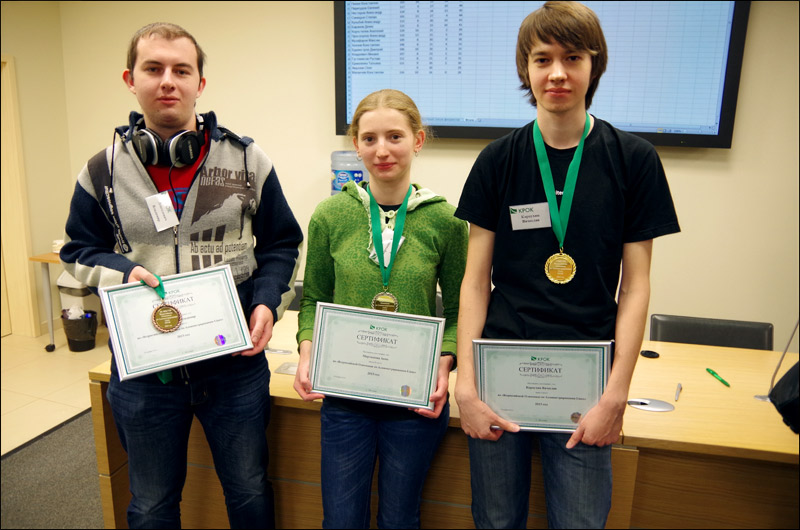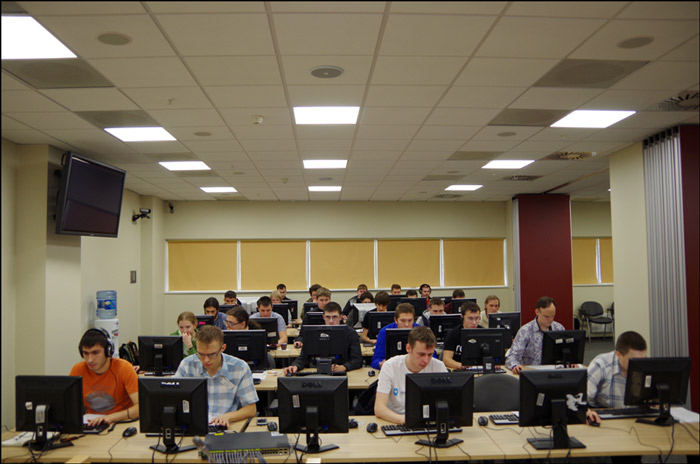Report and assignments from the All-Russian Olympiad on Administration of Linux-systems

Members
November 19th was the final round of the Linux Administration Olympiad among students and young professionals. I have been doing such Olympics for several years now: the first 4 Olympiads were just for administering mixed systems, but for the last 2 years we have focused on Linux.
The last Olympiad was rather unusual. First, instead of one standard distance qualifying round, we did two steps - simple and more complicated. Secondly, as I promised in the announcement, we prepared a special dish for the final: 27 participants of the final had to set up a combat cluster and integrate it into the company's infrastructure modeled on the simulator.
')
Below there will be tasks with answers, a description of the practical task and details, but for now, meet the winners:

Vladimir, Anna and Vyacheslav
- I place - Vyacheslav Karpukhin from St. Petersburg (last year he took III place).
- II place - Anna Martynova from Moscow.
- III place - Vladimir Dovgelevich from Krasnodar.
First tour
The Olympiad consisted of three rounds: qualifying, theoretical and practical. A little less than 500 people registered for the qualifying round. All questions on this tour were offered answers, from which you had to choose the right ones. The greatest difficulties were caused by questions, in which there were several correct answers and it was necessary to specify everything.
Here are the tasks of the first round with the answers .
Second round
In the second round we selected participants who showed the best 100 results in the qualifying selection. On this tour, most of the questions were open, that is, you had to write the answer yourself in the text field.
Both in the first and in the second round there was very little time to think - here either you know or you do not know. But, understanding that everyone perfectly knows how to use the search on the Internet, we decided to further complicate the life of the participants. We replaced all Latin characters in Cyrillic characters in commands and their conclusions when their spelling matches. For example, these are the letters “a”, “e”, “o”, “c”. Thus, to “punch” quickly the text from the screen in Google became somewhat difficult. I think it gave some advantages to those who know the system well.
The link is the task of the second round with the answers .
Third round
In the final round we invited 30 people who scored the highest points in the second round. Of these, 18 people were not from Moscow. We had to correct the list of participants for the final several times, because some could not come, others indicated incorrect data when registering, and still others simply did not indicate them ... As a result, we lost a lot of time on organizational issues. We apologize to those participants who, because of this, had to book tickets to Moscow at the last moment and plan a trip.
In the final, the guys were waited by a practical task, similar to the tasks with which the specialists of the integrator company have to have real-life business. These were not separate tasks affecting different areas of Linux, but one multi-stage task of building a working complex.

Final Tour Hall
The finalists needed to set up a highly reliable cluster of two virtual machines in 5 hours, link their storages with synchronous replication at the block level, and then organize a file service that authenticates users through the Active Directory domain. Of course, we are talking about Samba + CTDB, and DRBD was supposed to be used as a replication tool. It was necessary to set up a cluster file system on top of the replicated block devices, and here participants had a blank check (for example, you could put either gfs2 or ocfs2), because We checked this task functionally: through one node we created temporary files, and right there from the second node we checked that they were accessible from it.
In addition, it was necessary to ensure the automatic creation of home directories of users upon the first connection - with the necessary permissions. And domain administrators needed to be allowed to log in to cluster nodes via ssh with their credentials. This also required the creation of home directories, if they did not already exist. To perform this part, participants had to correctly include clustered Samba into the domain, configure the NS service and PAM modules.
And for a snack it was proposed to achieve the work of the whole complex with SELinux, included in the Enforcing mode.
Here are the final tasks .
Final results
I must say that no one completed all the tasks in 5 hours. But many have coped with DRBD and the cluster file system. According to the participants, the greatest difficulties arose when the cluster was included in the MS infrastructure. The main problem, of course, was the time limit. There are plenty of documents on the Internet on this topic, but it was not easy to find an exhaustive one. Accordingly, participants had to choose between fruitless searches and attempts to experiment themselves. As a result, the task was solved by someone through shaman dances, and by someone - as in general, it was intended.
The result was a remarkable practical task, and according to our statistics, most people who come to us for interviews, in their admin practice, sooner or later were forced to solve this problem.
Some statistics
Almost all the finalists somehow came across administration for work. And it was difficult to reach the final without good practice. And only those who constantly administer Linux systems could receive it either during their studies at the university or after their work.
Here is the distribution of all participants in the first qualification round:
- 59% have experience as an IT specialist.
- 25% have no experience, but they learn a lot of things themselves.
- 7% versed at university level
- 9% of newcomers, and they participated to understand where to develop.
By gender, of course, there is a huge advantage for the guys, but two girls went to the final - and one of them, Anna Martynova, for the first time in our history of administrative competitions won the top three winners (and took second place).
Source: https://habr.com/ru/post/204108/
All Articles